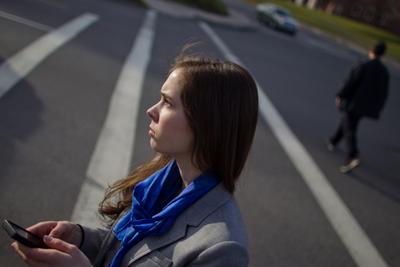Janurary 18, 2013 • By William Sweet
“Look both ways before crossing the street.”
It’s a lesson that most of us learn by the age of 6. But according to Leah Thompson ’15, who spent this past summer studying pedestrian behavior, it’s also a lesson that many adults have managed to unlearn or ignore.
The culprit, in many cases, is the smartphone.
In a study published in the current issue of the peer-reviewed journal Injury Prevention, Thompson and a team of researchers discovered that almost a third of the people crossing the street were distracted in some way, often by their phones or MP3 players. “This is the first published observational study with sufficient power to examine the impact of texting on real-world pedestrian behavior,” Thompson wrote in the article.

People who write text messages while crossing the street are almost four times more likely to violate the commandments drilled into every preschooler. They don’t obey the lights, they cross mid-intersection, or they fail to look both ways. People texting or talking on the phone walk more slowly. People listening to music generally walk faster. Everyone tethered to technology tends to ignore traffic and traffic lights.
Thompson, who was lead researcher and author for the study on behalf of the University of Washington’s Harborview Injury Prevention and Research Center, said that personal technology seems to magnify what she calls “pedestrian arrogance,” the assumption that you’re safer than you actually are while crossing the street.
“They don’t set out and say, ‘I’m going to do this stupid thing,’” she said. “It’s inattention; it’s preoccupation. When you first get your license, you’re super-careful, right? And then you get more used to driving, and it becomes more automatic. We all learn to walk when we’re really young, so walking is just as automatic a thing for us.”
This can make for some slapstick—Thompson admits that sneezing-while-distracted once sent her rolling down a hill—but distraction in traffic can be deadly. An estimated 60,000 pedestrians are injured by cars each year, and 4,000 are killed. A study in Vancouver, British Columbia found that around 15 percent of car-pedestrian fatalities are attributable to pedestrian behavior.
While there is extant research about the dangers of driving while texting—the National Safety Council estimated last year that at least 1.6 million car crashes in the U.S. involved cell phones and texting—Thompson’s work breaks ground in the study of pedestrian distraction.
She said the researchers hope that this study will start conversations similar to those that have resulted in states banning or restricting cell phone use in cars.
Thompson, a Portland resident on a pre-med track, started her summer gig at Harborview setting up research for a study on football-related concussions. But because the actual research phase would not start until Thompson was back at Amherst, her supervisor, Dr. Beth E. Ebel, directed her toward studying pedestrian distraction.
Thompson and two other students staked out 20 intersections in Seattle during the heaviest times of day for traffic, selecting crosswalks with the highest rates of pedestrian injuries. Armed with timers and notepads, they took notes on more than 1,100 people crossing the street.
To avoid tainting the research, they attempted to interact with people as little as they could, with varying degrees of success. When some of the people approached them and found out what the project was—the researchers kept it vague—they responded positively, and many remarked that they or their friends had either been hit by cars while walking the street or had had close calls. Indeed, the researchers observed a few close calls themselves, Thompson said.
While most of the pedestrians obeyed the lights, two-thirds of them—with and without phones—failed to look both ways. Age and other demographic factors didn’t seem to play a role in who chose to ignore the rules. Technology and, surprisingly, gender did: Texters were almost four times as likely to do something unsafe, and women were twice as likely as men to forget to look before crossing.
Thompson has no explanation for why women were less likely to look, but the risk of texting is fairly clear: it just eats up much more of your attention.
“There are two components of the distraction: There’s cognitive distraction—your mind has to think about what you want to say in the text—and then there’s the physical demands of moving your thumbs and holding the phone and looking at it,” she said.
Thompson said she is particularly troubled with how people her age seem to have become increasingly compulsive about checking their smart phones. “It’s becoming more socially acceptable to be distracted by technology while you’re interacting with other people,” she said. This has worrisome implications even beyond the crosswalk. “People are more likely to be texting or half-listening your conversation, and are less likely to be focused on each other honestly, giving people the attention that they deserve.”
She sees such distraction as a problem in academia as well. “Respect is fundamental to good student-teacher interactions, and I really think technology, laptops and things, are creating a barrier. Technology ultimately diverts your attention.”
As new technologies are developed to satisfy this now-constant need for stimulation, public safety policies will have to keep up, Thompson said. A ban on texting while walking would be hard to enforce, however, so fostering safety will also have to include changing individuals’ attitudes, she added, citing how societal perceptions of smoking and drunk driving have evolved over time.
As you might expect, Thompson’s research has had an effect on her own cell phone use—to a point.
“I never use my phone when I walk across streets anymore,” she said. “I’m very good about looking left and right.”
“But,” she confessed, “I still do text when I’m on the sidewalk.”
Note: for more about the study, follow these links to stories by USA Today, ABC News, NBC News, NPR News and Bloomberg News.
Photo by Rob Matson